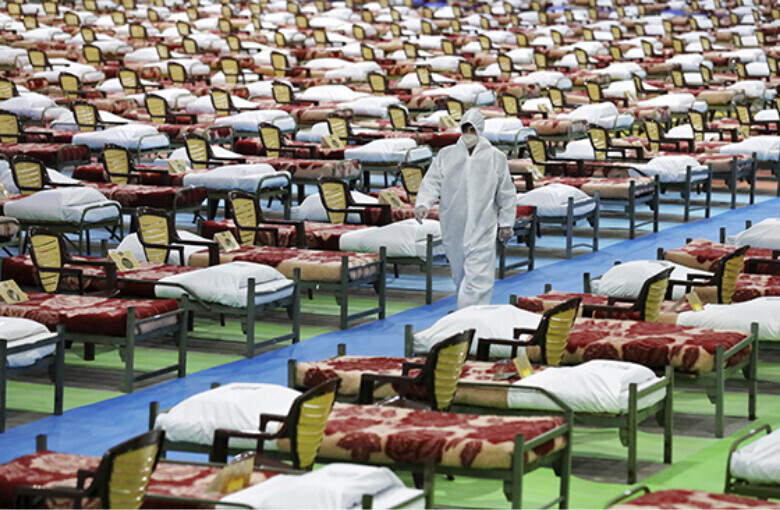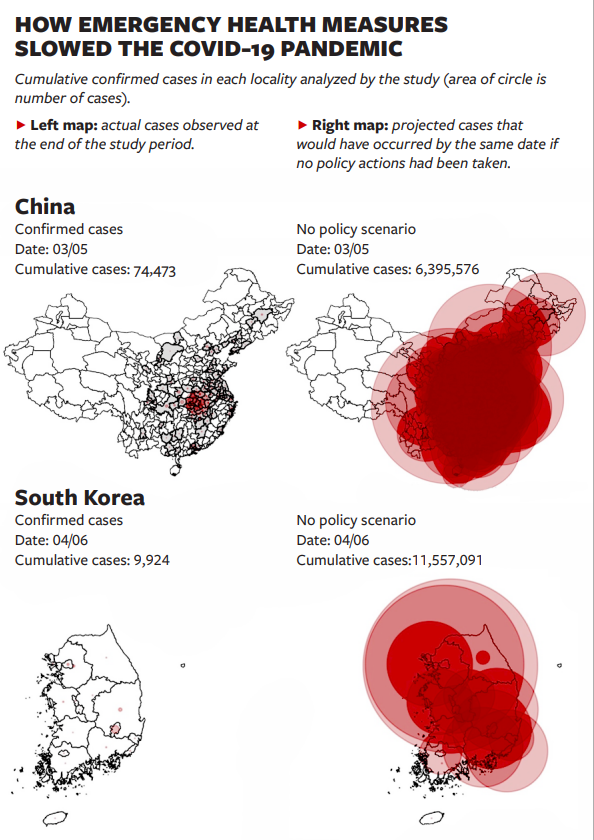hankyoreh
Links to other country sites 다른 나라 사이트 링크
11.55 million Koreans would have been infected if it weren’t for social distancing measures

An additional 11.55 million South Koreans would have been infected by the novel coronavirus if stringent disease control measures had not been implemented, an analysis estimates. This is some 1,165 times greater than the population of individuals who were actually infected.
On June 8, a research team from the University of California, Berkeley published an analysis in the eminent science journal Nature concluding that the governments of six countries, including South Korea and the US, were able to avert the infections of 530 million people through social distancing and other measures to prevent the spread of COVID-19. The team went on to estimate that 62 million people would have received positive results in diagnostic testing for the populations observed.
The research team analyzed the effects of 1,717 measures implemented by six countries -- South Korea, the US, China, Italy, Iran, and France -- between January and Apr. 6 to control the spread of COVID-19, including travel restrictions, the closing of schools and businesses, and remaining at home.
“I don’t think any human endeavor has ever saved so many lives in such a short period of time,” said Solomon Hsiang, director of UC Berkeley’s Global Policy Laboratory.
“There have been huge personal costs to staying home and canceling events, but the data show that each day [of sacrifice] made a profound difference,” he added.

Currently, around 7 million people around the world have been diagnosed with the virus, while 400,000 have lost their lives. But according to the research team, that number would have been unimaginably higher without the disease control measures. In the case of China, where 74,473 people tested positive during the analysis period through Mar. 5, the analysis estimated that 6,395,576 people -- 85.9 times as many -- would have tested positive without disease control measures such as the lockdown imposed on the city of Wuhan. South Korea had a cumulative total of 9,924 patients diagnosed with the virus as of Apr. 6; according to the research team, 11,557,091 people -- 1,165 times as many -- would have tested positive without measures such as intensive social distancing.
The prevention effects associated with disease control measures were found to differ between countries. The total estimated populations who would have been diagnosed without prevention measures amounted to 227 times as many in Iran, 17 times in Italy, 14 times in the US, and 12 times in France.
The team also found that while isolation measures such as staying at home, closing businesses, and declaring states of emergency showed clear effects, travel restrictions and bans were effective in Iran and Italy but did not show clear efficacy in countries such as the US.
“Our analysis of existing policies indicates that seemingly small delays in policy deployment likely produced dramatically different health outcomes,” the research team said.
By Lee Keun-young, staff reporter
Please direct comments or questions to [english@hani.co.kr]

Editorial・opinion
![[Column] The state is back — but is it in business? [Column] The state is back — but is it in business?](https://flexible.img.hani.co.kr/flexible/normal/500/300/imgdb/original/2024/0506/8217149564092725.jpg) [Column] The state is back — but is it in business?
[Column] The state is back — but is it in business?![[Column] Life on our Trisolaris [Column] Life on our Trisolaris](https://flexible.img.hani.co.kr/flexible/normal/500/300/imgdb/original/2024/0505/4817148682278544.jpg) [Column] Life on our Trisolaris
[Column] Life on our Trisolaris- [Editorial] Penalties for airing allegations against Korea’s first lady endanger free press
- [Editorial] Yoon must halt procurement of SM-3 interceptor missiles
- [Guest essay] Maybe Korea’s rapid population decline is an opportunity, not a crisis
- [Column] Can Yoon steer diplomacy with Russia, China back on track?
- [Column] Season 2 of special prosecutor probe may be coming to Korea soon
- [Column] Park Geun-hye déjà vu in Yoon Suk-yeol
- [Editorial] New weight of N. Korea’s nuclear threats makes dialogue all the more urgent
- [Guest essay] The real reason Korea’s new right wants to dub Rhee a founding father
Most viewed articles
- 1[Column] Why Korea’s hard right is fated to lose
- 260% of young Koreans see no need to have kids after marriage
- 3Amid US-China clash, Korea must remember its failures in the 19th century, advises scholar
- 4[Column] The state is back — but is it in business?
- 5Japan says it’s not pressuring Naver to sell Line, but Korean insiders say otherwise
- 6AI is catching up with humans at a ‘shocking’ rate
- 7S. Korean chaebols comprise 84% of GDP but only 10% of jobs
- 8Hybe-Ador dispute shines light on pervasive issues behind K-pop’s tidy facade
- 9[Column] Life on our Trisolaris
- 10[Reportage] New funeral culture taking hold in South Korea